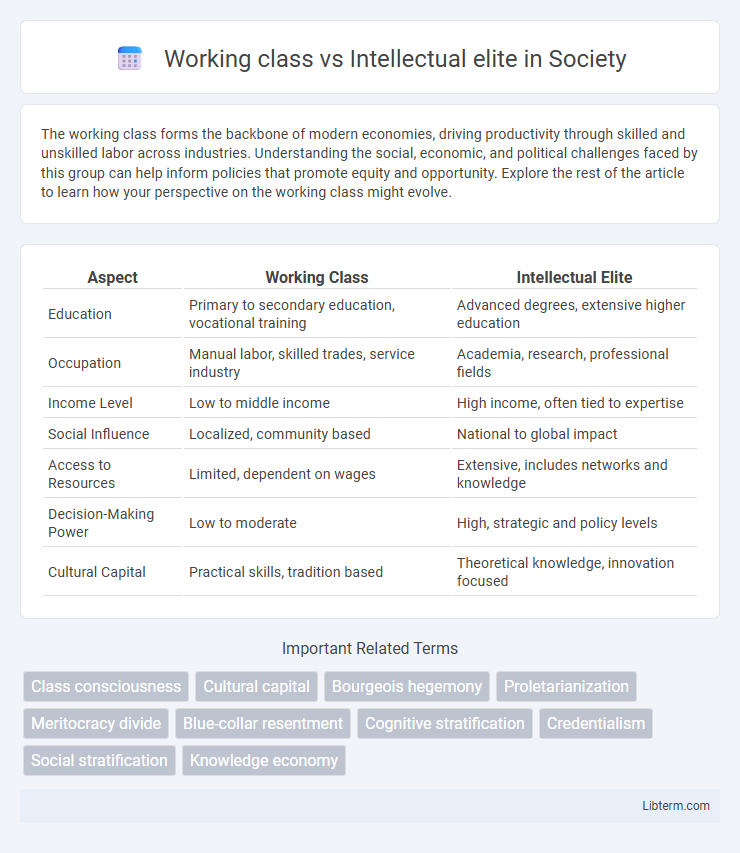The working class forms the backbone of modern economies, driving productivity through skilled and unskilled labor across industries. Understanding the social, economic, and political challenges faced by this group can help inform policies that promote equity and opportunity. Explore the rest of the article to learn how your perspective on the working class might evolve.
Table of Comparison
| Aspect | Working Class | Intellectual Elite |
|---|---|---|
| Education | Primary to secondary education, vocational training | Advanced degrees, extensive higher education |
| Occupation | Manual labor, skilled trades, service industry | Academia, research, professional fields |
| Income Level | Low to middle income | High income, often tied to expertise |
| Social Influence | Localized, community based | National to global impact |
| Access to Resources | Limited, dependent on wages | Extensive, includes networks and knowledge |
| Decision-Making Power | Low to moderate | High, strategic and policy levels |
| Cultural Capital | Practical skills, tradition based | Theoretical knowledge, innovation focused |
Defining the Working Class and Intellectual Elite
The working class typically consists of individuals engaged in manual labor or industrial work, often characterized by hourly wages and limited formal education. The intellectual elite comprises highly educated professionals and academics who engage in knowledge-based professions, influencing cultural, scientific, and political discourse. Distinct differences in education, occupation, and social influence fundamentally define these two social strata.
Historical Evolution of Social Classes
The historical evolution of social classes reveals a complex dynamic between the working class and the intellectual elite, with industrialization catalyzing the expansion of the proletariat and the rise of a knowledge-based elite. The working class historically engaged in manual labor within factories and industrial sectors, while the intellectual elite, comprising academics, professionals, and policymakers, shaped cultural and political discourse through education and specialized knowledge. Over time, technological advancements and shifts in economic structures have increasingly blurred class boundaries, yet disparities in access to education and economic power continue to sustain distinct social hierarchies.
Educational Disparities and Intellectual Capital
Educational disparities between the working class and intellectual elite significantly impact the accumulation and distribution of intellectual capital, with the elite often accessing advanced learning resources, institutions, and networks that enhance cognitive skills and innovation potential. The working class faces systemic barriers such as underfunded schools and limited opportunities for higher education, which restrict the development of critical thinking and specialized knowledge essential for intellectual capital growth. These disparities perpetuate social inequality by concentrating intellectual assets within elite groups, limiting social mobility and economic diversification.
Economic Inequality and Job Opportunities
Economic inequality intensifies the divide between the working class and intellectual elite, as wage disparities and access to resources disproportionately favor those with advanced education and specialized skills. Job opportunities in high-growth industries increasingly require intellectual expertise, leaving working-class individuals with fewer prospects for upward mobility and stable employment. Structural barriers such as limited access to quality education and professional networks further exacerbate economic stratification between these groups.
Cultural Values and Worldview Differences
The working class often emphasizes practical skills, community solidarity, and tradition, valuing tangible achievements and shared experiences rooted in their daily lives. In contrast, the intellectual elite prioritizes abstract reasoning, innovation, and critical thinking, fostering a worldview that champions progressive ideas and cultural refinement. These divergent cultural values shape distinct approaches to social issues, education, and authority, reflecting fundamentally different perceptions of identity and success.
Political Influence and Representation
The working class often faces underrepresentation in political institutions despite forming a substantial portion of the electorate, limiting their influence on policy decisions. Intellectual elites, equipped with higher education and social capital, dominate political discourse and leadership roles, shaping legislation and public opinion to align with their perspectives. This disparity in representation perpetuates socio-economic inequalities and affects the prioritization of issues such as labor rights, education, and social welfare.
Social Mobility and Barriers
Social mobility between the working class and intellectual elite is often hindered by systemic barriers such as unequal access to quality education, social networks, and economic resources. The working class faces challenges like limited opportunities for upward mobility due to educational disparities and cultural capital deficits, while the intellectual elite benefits from inherited advantages and institutional support. Breaking these barriers requires policy interventions targeting affordable education, inclusive social policies, and support systems that reduce socioeconomic inequalities.
Stereotypes and Media Portrayals
Stereotypes of the working class often depict them as uneducated, labor-intensive, and resistant to change, while the intellectual elite are portrayed as highly educated, cultured, and sometimes out of touch with everyday realities. Media portrayals frequently reinforce these dichotomies through sitcoms, news coverage, and films, emphasizing class divisions by highlighting working-class struggles and intellectual elitism. Such representations influence public perceptions, perpetuating social biases and impacting attitudes toward education, employment, and social mobility.
Tensions and Collaboration in Modern Society
Tensions between the working class and intellectual elite often stem from differing perspectives on economic policies, education access, and cultural values, which can generate feelings of mistrust and social division. Collaboration occurs through initiatives that promote inclusive dialogue, such as community forums and interdisciplinary projects, fostering mutual understanding and shared goals. Bridging gaps between these groups enhances innovation and social cohesion, driving equitable progress in modern society.
Bridging the Divide: Towards Mutual Understanding
Bridging the divide between the working class and intellectual elite requires fostering open dialogue and mutual respect for diverse perspectives on economics, culture, and societal values. Emphasizing shared goals such as social equity and community well-being helps to dismantle stereotypes and build collaborative platforms. Educational initiatives that blend practical skills with critical thinking promote empathy and reduce fragmentation in social and political discourse.
Working class Infographic

 libterm.com
libterm.com